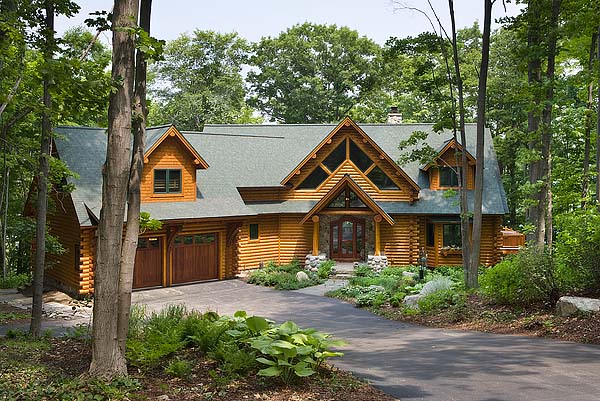Staining Tips for Log and Timber Homes

Staining log siding serves multiple purposes. Stain adds style to the exterior of a log or timber home. It also protects the surface of the home, acting as a shield against the elements, UV rays and moisture, which can damage the wood.
Taking the proper precautions when staining can ensure that your log siding looks great and provides maximum protection to your home. Here are some dos and don’ts for preparing log siding for stain and applying wood stain products.
Do select quality logs.
Quality logs are critical to successful staining. Take Pine log siding. The sap ring in a Pine log measures two-thirds the diameter of the tree trunk. Thus, most Pine log siding is made from sapwood that will bleed sap for two to three years. This sap can cause blotches to seep through even the best stain applications and create an eyesore on your home’s exterior.
There is no sap at all, however, in the quality Northern White Cedar siding and paneling from Heartwood Mills, because it’s cut from the heartwood of the Cedar tree. White Cedar sapwood typically measures only ½ to 1-inch of the diameter of the tree trunk, and we remove all sapwood during the drying and milling process.
Using log siding milled from sapwood may save you money up front, but it will cost you in the long run. You’ll have to invest more time, money and effort to maintain the wood. Plus, you risk compromising the appearance of your home.
Do prepare the log siding carefully.
Your work begins long before you pick up a brush or sprayer. To ensure a polished finish, you must put in the time to properly prepare the log siding and your home for staining. First, cover or remove anything you don’t want stained such as patio furniture, planters, windows and even concrete sidewalks.
Then wash and clean the log siding with a trisodium phosphate (TSP) solution. This will remove dust, dirt and other impurities that could affect coverage and it will open up the cellular structure of the log siding to enable the stain to penetrate further into the grain. Allow the log siding to dry completely before you begin staining.
Don’t choose a stain that isn’t suited for log siding.
There are a wide variety of stain products available, so research your options carefully before making a selection. Visit your local stain or paint store and check online to make sure you’re getting the quality product you want for a fair price. In general, higher-quality stains have higher price tags.
The predominant enemy of stain is the sun’s UV rays. In general, lighter stain colors fail faster than darker stain colors because UV rays can penetrate further into the lighter product. In addition to color options, look for stain formulated specifically for log siding. Also check for guarantees as well as the manufacturer’s estimated life expectancy.
Don’t ignore the manufacturer’s recommendations.
Even a high-quality stain will fail if you don’t properly prep log siding and apply stain correctly. When staining, always follow the manufacturer’s recommendations for application. It’s also important to remember that unlike paint, stain is designed to soak into wood. If you apply your stain like a thick coat of paint, it will ultimately chip, crack and peel.
You can apply stain with a brush or sprayer. While a sprayer is fast and efficient, a brush allows you to push the stain into the wood and harder-to-reach areas. Brushing is the best option when you’re applying stain alone. Only choose a sprayer when someone can follow you to back-brush the stain into the wood.
No matter your application method, work in small sections to maintain a wet edge. If the stain dries before you move on to the next section, you could be left with unsightly lines on your log siding. Apply two coats of stain and wait the recommended time between coats for the best result.
Do pay attention to the sun and the weather.
The weather can affect how well your stain dries, covers and adheres to your log siding. Avoid staining when it’s wet or humid outside. Also avoid staining on extremely hot or cold days. The best temperature for application is typically around 70 degrees, but refer to the manufacturer’s recommendations for your particular stain product.
The sun can have long-term effects on stain performance. If you’re still designing your home, consider positioning it to minimize direct sun exposure. It’s also smart to have an 18 – 24-inch overhanging soffit on the roof to help keep log siding out of the sun.
Heartwood Mills’ artisans are well-versed in the staining process. We’re happy to answer questions about prepping and staining your log siding.
